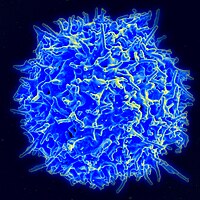
Photo from wikipedia
Inspection of the naive B cell repertoire specific for an HIV vaccine immunogen provides actionable information for human vaccine design and advancement. Learning from naive B cells Despite decades of… Click to show full abstract
Inspection of the naive B cell repertoire specific for an HIV vaccine immunogen provides actionable information for human vaccine design and advancement. Learning from naive B cells Despite decades of intensive research, HIV vaccines are unable to generate broadly neutralizing antibodies that are likely necessary for protection. One vaccine candidate, eOD-GT8, was designed to bait naive B cells that may be capable of producing antibodies similar to VRC01, a potent CD4-binding site–targeting antibody with breadth. Havenar-Daughton et al. inspected the potential of human naive B cells to recognize eOD-GT8, and isolated B cells that used similar genes as those used to make VRC01. They also observed B cells with immunoglobulin genes similar to those used in other types of broadly neutralizing antibodies, some with a more conventional maturation path than VRC01. Their results suggest that vaccination of humans with eOD-GT8 has the potential to eventually induce CD4-binding site broadly neutralizing antibodies, which would be a major step forward in HIV vaccines. Traditional vaccine development to prevent some of the worst current pandemic diseases has been unsuccessful so far. Germline-targeting immunogens have potential to prime protective antibodies (Abs) via more targeted immune responses. Success of germline-targeting vaccines in humans will depend on the composition of the human naive B cell repertoire, including the frequencies and affinities of epitope-specific B cells. However, the human naive B cell repertoire remains largely undefined. Assessment of antigen-specific human naive B cells among hundreds of millions of B cells from multiple donors may be used as pre–phase 1 ex vivo human testing to potentially forecast B cell and Ab responses to new vaccine designs. VRC01 is an HIV broadly neutralizing Ab (bnAb) against the envelope CD4-binding site (CD4bs). We characterized naive human B cells recognizing eOD-GT8, a germline-targeting HIV-1 vaccine candidate immunogen designed to prime VRC01-class Abs. Several distinct subclasses of VRC01-class naive B cells were identified, sharing sequence characteristics with inferred precursors of known bnAbs VRC01, VRC23, PCIN63, and N6. Multiple naive B cell clones exactly matched mature VRC01-class bnAb L-CDR3 sequences. Non–VRC01-class B cells were also characterized, revealing recurrent public light chain sequences. Unexpectedly, we also identified naive B cells related to the IOMA-class CD4bs bnAb. These different subclasses within the human repertoire had strong initial affinities (KD) to the immunogen, up to 13 nM, and represent encouraging indications that multiple independent pathways may exist for vaccine-elicited VRC01-class bnAb development in most individuals. The frequencies of these distinct eOD-GT8 B cell specificities give insights into antigen-specific compositional features of the human naive B cell repertoire and provide actionable information for vaccine design and advancement.
Journal Title: Science Translational Medicine
Year Published: 2018
Link to full text (if available)
Share on Social Media: Sign Up to like & get
recommendations!